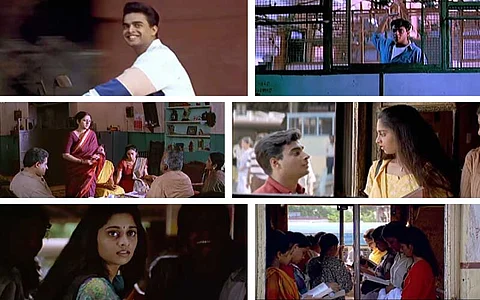
- Reviews
- Power List 2024
- Cannes 2024
- In-Depth Stories
- Web Stories
- News
- FC Lists
- Interviews
- Features
- FC SpecialsFC Specials

Trains are an integral part of a Tamil film romance, especially if it is directed by Mani Ratnam. But, what if Mani Ratnam used the trains in Alaipayuthey as a foreshadowing tool and as symbolism for Shakthi's home and her close-minded parents? Trains, along with the other closed spaces in the film (wedding hall, Shakthi's house and railway station), symbolise the doubts that Shakthi (Shalini Ajith) has about the possibility of a relationship with Karthik (Madhavan).
The events at the railway station almost always act as the precursor to a future scene. The first time Karthik and Shakthi meet at the railway station, we see them as two people in two trains, just like they are part of two households in different parts of the city.
The second time they meet, cinematographer PC Sreeram shows Shakthi inside the train. She does not escape the gaze of Karthik, standing on the platform.
The following scene has Karthik making his presence felt in front of Shakthi's house.
We then have the iconic proposal scene where Karthik says Naan unna virumbala, un mela aasapadala, nee azhaga irukka nu nenaikkala, anaa idhellam nadandhudumo nu bayama irukku. In this scene, PC Sreeram frames Shakthi inside the train, which represents her doubts about the relationship because of her traditional parents.
The next time we see Karthik and Shakthi at the railway station, the only time both of them are inside the train, Karthik tells Shakthi that his parents will visit her house to talk about their wedding. PC Sreeram frames the shot in the grid, which means there could be resistance to the proposal.
A couple of scenes later, Karthik's parents visit Shakthi's house only to get rejected by her parents.
After the rejection, Shakthi and Karthik decide to part ways. Shakthi goes back to her house, aka train, while Karthik is left stranded.
After going to Kerala for a medical camp, Shakthi still has doubts about the relationship. In the Evano Oruvan song, PC Sreeram frames Shakthi inside the tent, which shows she is still scared to oppose her parents.
Finally, when she is ready to overcome them, Shakthi proposes to Karthik in an open space — in front of the sea — representing unconditional love. This scene justifies the film's title. The shot shows Karthik and Shakthi surrounded by a small bridge and the sea. Both have crossed the bridge into a sea of love.
The next time PC Sreeram shows the railway station, we see Karthik searching inside a train for Shakthi. This is the second and final time we see Karthik inside a train in the film. In the next scene, Karthik goes to Shakthi's house to look for her.
In the second half of the film, Shakthi meets her mother and sister in the train, where they reveal the fact that her father has jaundice. A couple of scenes later, Shakthi goes to her house, only to see her dead father.
After all the obstacles the couple faces in the film, they finally unite in the hospital, which has a blue tone, representing their boundless love for each other, just like the water in the ocean.
Alaipayuthey has superb dialogues, performances, and music. These facets of the film, still admired even today, could fade when similar stories emerge from the newer filmmakers. But, the symbolism and metaphors in the movie render the film timeless and set its creator Mani Ratnam apart from the rest.